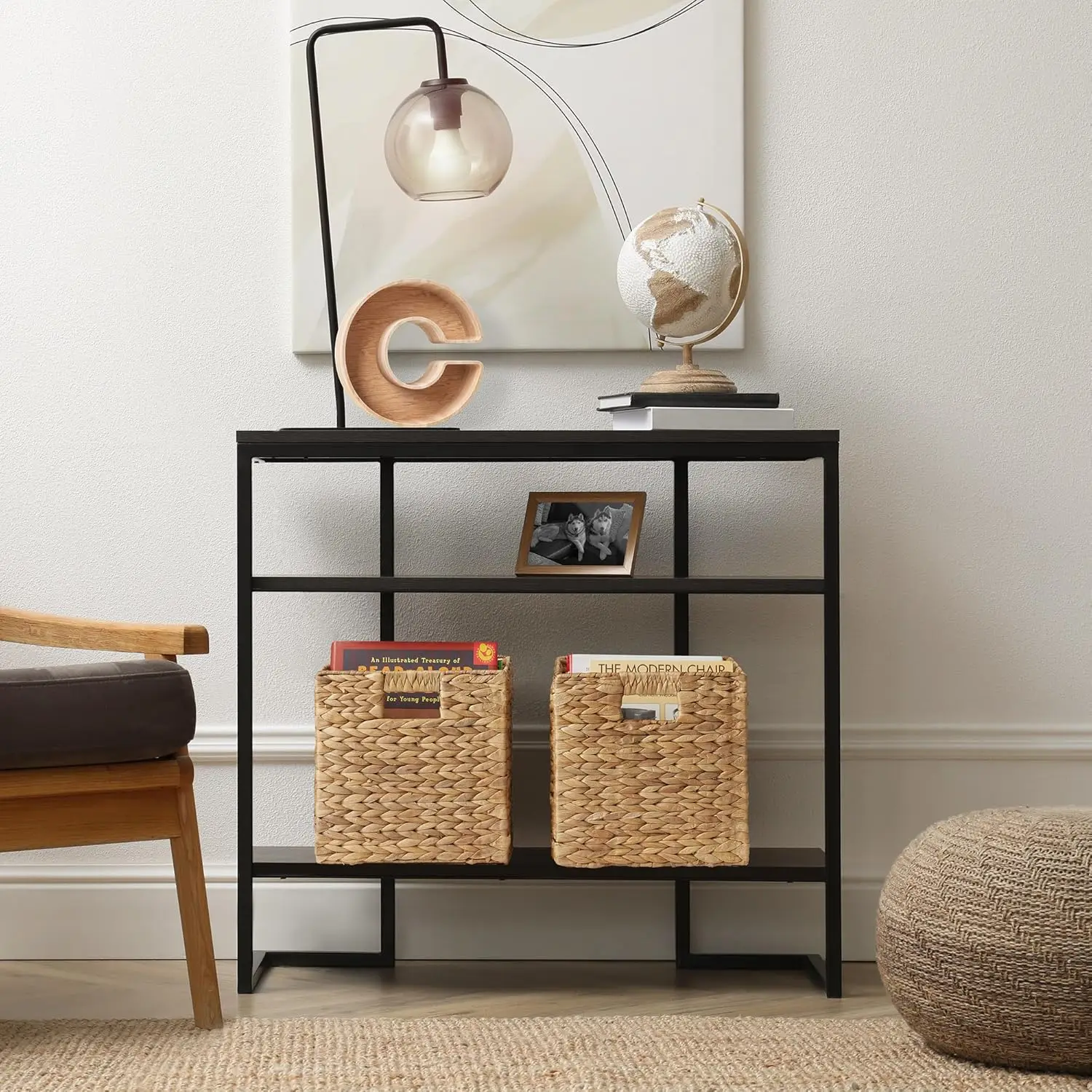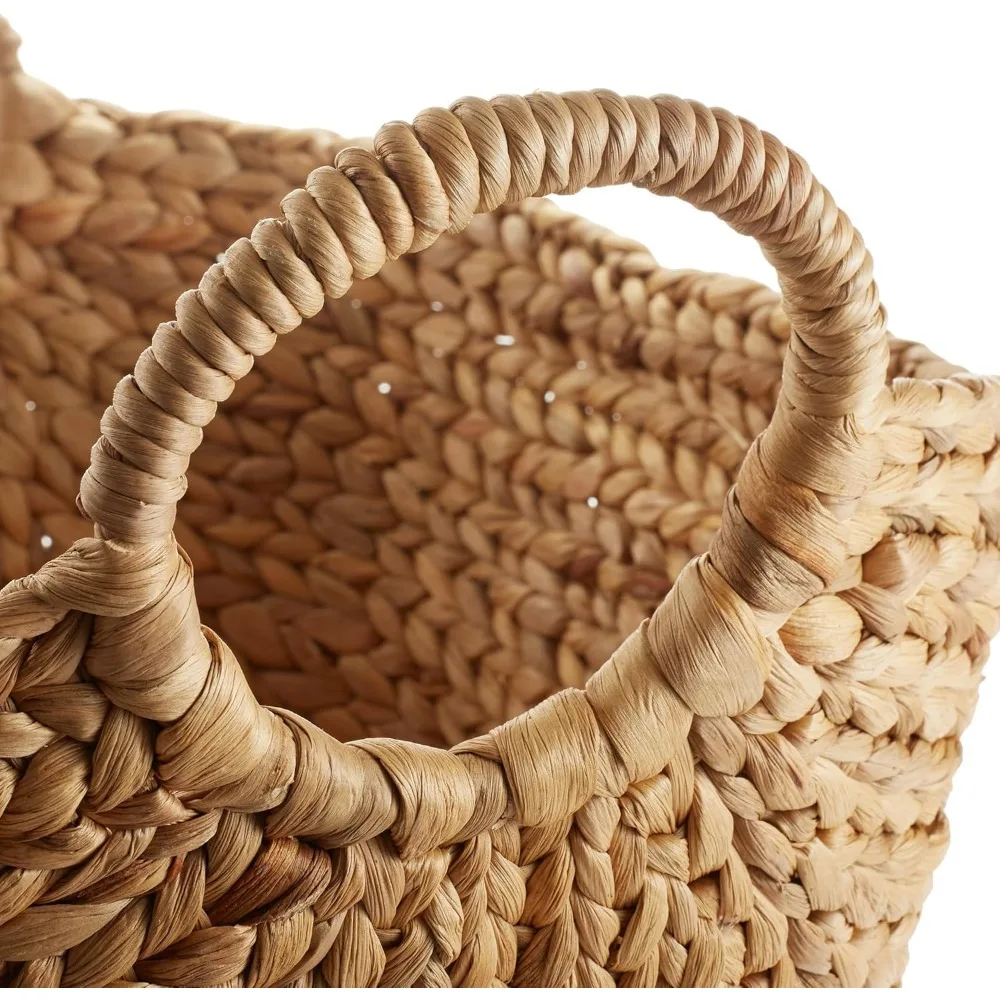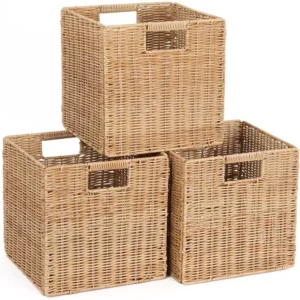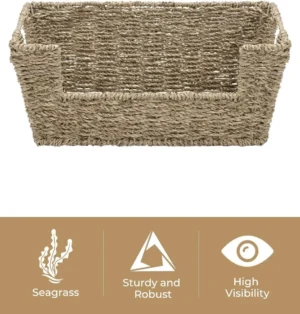Baskets are more than just storage containers—they’re beautiful home accents that deserve proper care to maintain their charm and functionality. Whether you’ve invested in premium wicker baskets from Tidy Treasure or have beloved baskets from other sources, understanding how to properly care for them ensures they remain beautiful and functional for years to come.
1. Understanding Basket Materials: The Foundation of Proper Care
Before selecting any cleaning products or maintenance routines, it’s essential to identify what your basket is made from. Different materials require different care approaches to avoid damage and preserve their natural beauty.
The most common basket materials include:
- Natural fibers:
- Wicker (typically made from willow branches)
- Rattan (a climbing palm with flexible stems)
- Bamboo (lightweight and durable grass)
- Seagrass (dried coastal plants)
- Water hyacinth (aquatic flowering plant)
Jute (strong vegetable fiber)
Synthetic materials:
- Plastic wicker (weather-resistant synthetic fibers)
- Resin wicker (durable synthetic material molded to resemble natural wicker)
- Vinyl (flexible plastic material)
Natural fiber baskets generally require more gentle care as they’re susceptible to moisture damage, which can lead to mold, warping, or brittleness. Synthetic materials typically offer more durability and water resistance but may degrade with prolonged sun exposure.
Properly organizing laundry wicker baskets starts with understanding their material composition, which determines how to clean and maintain them over time.
Our collection of rattan baskets showcases a variety of weaving styles and forms, each requiring specific care based on their construction and finish.
2. Essential Basket Care Products: Building Your Maintenance Kit
Creating a basket care kit with the right products ensures you’re prepared to maintain your baskets properly without causing damage. Here are the essential items to include:
Gentle Cleaning Agents
- pH-neutral soap solutions (like mild dish soap diluted in water)
- White vinegar solution (1 part vinegar to 3 parts water)
- Baking soda paste for spot cleaning
- Lemon juice for natural brightening
- Specialized wicker/rattan cleaner (for stubborn issues)
Cleaning Tools
- Soft-bristled brushes (paintbrushes work well for between weaves)
- Microfiber cloths (non-abrasive for dusting and cleaning)
- Soft toothbrushes (for detail cleaning in tight spaces)
- Vacuum with brush attachment (for thorough dust removal)
- Spray bottles (for applying cleaning solutions)
Protective Products
- Natural oils (lemon oil, mineral oil) for conditioning natural fibers
- Furniture-grade beeswax for sealing and protecting
- Clear polyurethane spray for water resistance (test first on inconspicuous area)
- UV protectant spray for baskets in sunny locations
Storage Aids
- Cotton dust covers
- Silica gel packets for humidity control
- Acid-free tissue paper for stuffing and maintaining shape
Comprehensive wicker basket care guides suggest having both multi-purpose products for regular maintenance and specialized solutions for specific problems that may arise.
When selecting products for wicker baskets with lids, remember that the closure mechanisms and hinges might need special attention to maintain proper function alongside the basket’s appearance.
3. Daily & Weekly Basket Maintenance: Preventative Care Essentials
Regular maintenance is the key to extending the life of your baskets. Simple daily and weekly routines can prevent most common basket problems before they start.
Daily Basket Care
- Gentle Dusting: Use a soft cloth or feather duster to remove surface dust before it settles into weaves.
- Proper Handling: Lift baskets from the bottom instead of by the rim or handles to prevent warping.
- Strategic Placement: Keep baskets away from direct sunlight, heating vents, and high humidity areas.
Weekly Basket Care
- Thorough Dusting: Use a vacuum with brush attachment on low power to clean between weaves.
- Inspection Check: Look for early signs of mold, mildew, or insect activity.
- Rotation: Rotate baskets used for display to ensure even exposure to environmental factors.
Tip: Place a small cloth underneath items stored in baskets to protect the basket bottom from scratches and stains.
Maintaining proper storage habits significantly extends the life of laundry organization baskets, especially those used frequently and exposed to moisture from damp clothes.
4. Cleaning Natural Fiber Baskets: Material-Specific Techniques
Natural fiber baskets require special attention during cleaning to prevent damage while effectively removing dirt and stains.
Wicker & Rattan Basket Cleaning
- Dust thoroughly using a soft brush or vacuum attachment.
- Prepare a cleaning solution of mild soap and lukewarm water.
- Dampen a cloth in the solution and wring it out well—excess water is the enemy.
- Gently wipe the basket surfaces, following the direction of the weave.
- Clean between weaves using a soft toothbrush dipped in the solution.
- Rinse with a clean, damp cloth to remove soap residue.
- Air dry completely in a well-ventilated area, away from direct heat or sunlight.
Seagrass & Water Hyacinth Cleaning
- Use minimal moisture as these materials are highly susceptible to water damage.
- Spot clean only using a barely damp cloth with mild soap.
- Dry immediately with a clean towel.
- For stubborn dirt, try a dry cleaning approach using baking soda gently rubbed into the area, then vacuumed away.
⚠️ Warning: Never submerge natural fiber baskets in water or allow them to become saturated, as this can cause warping, mold growth, and structural weakening.

Our woven storage baskets collection features various natural materials that each have specific cleaning requirements to maintain their beautiful texture and structure.
5. Synthetic Basket Cleaning: Effective Products & Methods
Synthetic baskets offer greater cleaning flexibility due to their increased durability and water resistance.
Plastic & Resin Wicker Cleaning
- Dust regularly using a microfiber cloth or vacuum.
- Prepare a cleaning solution of dish soap and warm water.
- Wipe thoroughly with a cloth dampened in the solution.
- For stubborn stains, use a soft brush to scrub gently.
- Rinse with clean water by wiping with a damp cloth.
- For disinfection, use a diluted bleach solution (1 tablespoon bleach to 1 gallon of water) where appropriate.
Advantages of Synthetic Baskets
- Can withstand more thorough cleaning with water
- May be cleaned with a broader range of products
- Often suitable for bathroom and kitchen environments
- Some can even be hosed down outdoors (check manufacturer recommendations)
Outdoor Synthetic Basket Care
- Clean more frequently due to exposure to elements
- Apply UV protectant spray every 2-3 months to prevent color fading
- Check for water accumulation after rain and dry thoroughly
Our wicker laundry baskets with lids in synthetic materials can generally withstand more moisture exposure, making them ideal for bathroom environments.
6. Addressing Common Basket Problems: Targeted Solutions
Even with regular maintenance, baskets may occasionally develop specific issues that require targeted solutions.
Mold and Mildew Removal
- Take the basket outdoors to prevent spore spread.
- Vacuum thoroughly to remove loose mold spores.
- Apply white vinegar solution (equal parts white vinegar and water) to affected areas.
- Scrub gently with a soft brush.
- Dry in sunlight if possible—UV rays help kill remaining spores.
- Finish with a fan to ensure complete drying.
Stain Treatment by Type
- Food stains: Baking soda paste applied for 15 minutes, then brushed away
- Water marks: Equal parts white vinegar and olive oil gently rubbed in
- Ink: Small amount of rubbing alcohol on a cotton swab (test first)
- Rust: Lemon juice applied to the affected area, rinsed after 5 minutes
Odor Elimination
- Baking soda treatment: Sprinkle baking soda liberally, let sit overnight, then vacuum
- Charcoal deodorizing: Place activated charcoal in a breathable bag inside the basket for 24-48 hours
- Air and sunshine: Allow baskets to air out in indirect sunlight
Effortless laundry organization starts with baskets that are not only clean but also free from odors that could transfer to clothing.
Understanding basket weaving styles helps identify the best approach for repairs when structural damage occurs, as different weaving patterns require different repair techniques.
7. Conditioning & Protecting Baskets: Long-Term Preservation
After cleaning, conditioning natural fiber baskets helps maintain their flexibility and strength, preventing brittleness and cracking.
Natural Fiber Conditioning Process
- Ensure basket is completely clean and dry
- Apply conditioning oil with a soft cloth (options include):
– Lemon oil (provides natural scent and moisture)
– Mineral oil (odorless option)
– Boiled linseed oil (traditional but slow-drying) - Use sparingly—a little goes a long way
- Wipe away excess oil after 15 minutes
- Allow to fully absorb for 24 hours
Protective Sealants
Apply sealants only when necessary for baskets exposed to high-risk environments:
– Clear paste wax: Apply thinly with cloth, buff after drying
– Polyurethane spray: Use outdoors with minimal application (may change appearance)
– Water-repellent fabric spray: For cloth-lined baskets
Seasonal Protection
- Winter care: Add moisture to dry indoor air with humidifiers
- Summer protection: Use blinds or curtains to prevent UV damage
- Rainy seasons: Apply protective conditioners before exposure increases

Quality rattan storage baskets benefit tremendously from regular conditioning to maintain their flexibility and prevent cracking over time.
8. Basket Storage Solutions: Preserving Shape and Integrity
When not in use, proper storage techniques help baskets maintain their shape and structural integrity.
Optimal Storage Conditions
- Temperature: Cool, dry location (55-75°F)
- Humidity: Moderate levels (40-50%)
- Light: Minimal exposure to sunlight or bright artificial light
- Air circulation: Good ventilation to prevent mustiness
Proper Storage Techniques
- Clean thoroughly before storing
- Stuff with acid-free tissue paper to maintain shape
- Cover with cotton dust covers or pillowcases (avoid plastic which traps moisture)
- Place heavier baskets on bottom when stacking
- Insert shape supporters (rolled towels work well) for flexible baskets
Pest Prevention
- Cedar blocks naturally repel moths and many insects
- Regular inspection for early signs of pest activity
- Keep food residues thoroughly cleaned from baskets before storage
Innovative wicker laundry basket storage ideas can help maximize space while ensuring baskets remain in excellent condition during periods of non-use.
Black Wicker Baskets, Rattan Storage Baskets, Tall Wicker Baskets, Wicker Shelf Baskets, Woven Storage Baskets
5-Tier Distressed Black Wood Frame Storage Tower with Removable Wicker Baskets for Home Organization$715.80 Select options This product has multiple variants. The options may be chosen on the product pageWicker Laundry Baskets, Woven Laundry Baskets, Woven Storage Baskets
$392.02 Select options This product has multiple variants. The options may be chosen on the product pageRattan Shelf Baskets, Rattan Storage Baskets, Small Wicker Baskets, Square Wicker Baskets
Square Plastic Wicker Storage Baskets Set of 3 with Collapsible Design for Cube Storage Organization$185.47 Select options This product has multiple variants. The options may be chosen on the product pageWicker Baskets with Handles, Wicker Storage Baskets, Woven Storage Baskets
$137.92 Select options This product has multiple variants. The options may be chosen on the product pageLarge Wicker Laundry Baskets, Tall Wicker Baskets, Woven Laundry Hampers, Woven Storage Baskets
$130.54 Select options This product has multiple variants. The options may be chosen on the product pageWicker Hampers with Lids, Wicker Laundry Baskets with Lids, Wicker Laundry Hampers
$127.33 Select options This product has multiple variants. The options may be chosen on the product page
9. Products to Avoid: Protecting Your Baskets from Damage
Knowing what NOT to use on your baskets is just as important as knowing the right products.
Damaging Cleaning Agents to Avoid
- Bleach (except on certain synthetic materials and only when diluted)
- Ammonia-based cleaners
- Abrasive powders
- Furniture polish containing silicones
- Alcohol-based products on painted or lacquered baskets
Harmful Tools and Techniques
- Stiff brushes with hard bristles
- High-pressure water (power washers)
- Scrubbing pads or steel wool
- Excessive scrubbing on delicate weaves
Dangerous Environments
- Clothes dryers for damp baskets
- Heating vents for rapid drying
- Enclosed plastic bags for storage
- Direct contact with hot surfaces
Proper care of wicker hampers with lids should avoid these damaging elements to prevent deterioration of both the basket material and any hardware components.
10. Quick Reference Guide: Best Products by Basket Material
Use this handy reference chart to quickly identify the best products for your specific basket material:
| Basket Material | Cleaning Products | Conditioning Products | Tools | Cleaning Frequency |
|---|---|---|---|---|
| Wicker | Mild soap solution | Lemon or mineral oil | Soft brush, microfiber cloth | Dust weekly, deep clean quarterly |
| Rattan | White vinegar solution (1:3 with water) | Boiled linseed oil | Soft toothbrush, paint brush | Dust weekly, deep clean quarterly |
| Seagrass | Dry cleaning methods, minimal moisture | Light mineral oil | Vacuum with brush attachment | Dust weekly, spot clean as needed |
| Water Hyacinth | Barely damp cloth with mild soap | Coconut oil (sparingly) | Soft cloth, soft brush | Dust weekly, spot clean only |
| Bamboo | Mild soap solution | Food-grade mineral oil | Cotton swabs, soft cloth | Monthly cleaning |
| Synthetic Wicker | Dish soap solution, diluted bleach when needed | UV protectant spray | Soft brush, microfiber cloth | Monthly cleaning, rinse occasionally |
Our diverse wicker storage basket collection includes pieces made from various materials, each benefiting from material-appropriate care products.

11. DIY Basket Care Solutions: Effective Homemade Alternatives
You don’t always need specialty products to care for your baskets. These simple DIY solutions use common household items and can be just as effective:
Natural Cleaning Solution
- 1 cup warm water
- 1/4 cup white vinegar
- 1 tablespoon mild dish soap
- Optional: 5 drops lemon essential oil for fragrance
- Application: Mix in spray bottle, apply with soft cloth, wipe dry
Homemade Conditioning Treatment
- 2 parts olive oil
- 1 part lemon juice
- Application: Mix well, apply sparingly with soft cloth, buff after 15 minutes
Baking Soda Paste for Stains
- 3 tablespoons baking soda
- 1 tablespoon water
- Application: Mix to form paste, apply to stain, let dry, brush away
DIY Basket Freshener
- 1/2 cup baking soda
- 5-10 drops essential oil (lavender works well)
- Application: Mix well, sprinkle in basket, let sit overnight, vacuum thoroughly
These DIY laundry organization solutions can help maintain your baskets while being gentle on both the environment and your budget.
12. Frequently Asked Questions About Basket Care Products
Q: How often should I oil or condition my natural fiber baskets?
A: Generally, conditioning natural fiber baskets 1-2 times per year is sufficient, though baskets in dry environments may need quarterly conditioning.
Q: Can I use furniture polish on my baskets?
A: Most commercial furniture polishes are not recommended for woven baskets as they can build up in the weaves and attract dust. Stick to natural oils designed for basket care.
Q: Is Murphy’s Oil Soap safe for cleaning baskets?
A: While Murphy’s Oil Soap is generally safe for sealed wood products, it should be used very diluted and sparingly on baskets, as excess moisture can damage natural fibers.
Q: How can I tell if my basket is synthetic or natural material?
A: Synthetic materials often have a uniform appearance and feel slightly plastic to the touch. They also resist water better than natural fibers, which tend to have more variation in color and texture.
Q: Should I throw away a basket that has developed mold?
A: Not necessarily. Many wicker baskets used for laundry can be salvaged from mold with proper cleaning using vinegar solutions and thorough drying in sunlight.
By following these guidelines and using appropriate products, your beautiful baskets can remain functional and attractive for many years, continuing to add natural warmth and organization to your home. Remember that prevention through proper maintenance is always easier than restoration after damage has occurred.







